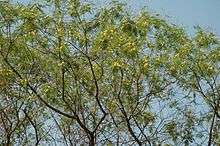Parasenegalia visco
Parasenegalia visco is a perennial tree found at higher elevations in northern Argentina, Bolivia, Chile and Peru. It has also been introduced to Africa. Common names for it include arca, visco, viscote, viscote blanco and viscote negro.[3] It grows 6–25m tall and it has fragrant yellow flowers in the Spring. In Bolivia is found at an altitude of 1500–3000m.[4]. It has light to dark reddish brown twigs and small white flowers. It is cultivated for use in cabinetmaking.[5]
| Parasenegalia visco | |
|---|---|
 | |
| Parasenegalia visco | |
| Scientific classification | |
| Kingdom: | |
| (unranked): | |
| (unranked): | |
| (unranked): | |
| Order: | |
| Family: | |
| Genus: | |
| Species: | P. visco |
| Binomial name | |
| Parasenegalia visco | |
 | |
| Range of Parasenegalia visco | |
| Synonyms[1][2] | |
| |
Methanol extract of Senegalia visco has been shown to have short-term and long-term anti-inflammatory effects in lab rats.[6] Among the class of compounds characterized from S. visco leaves, the triterpenoid lupeol, α-amyrin and β-amyrin may be mainly responsible for the pharmacological activities.[7]
References
- Seigler DS, Ebinger JE. (2017). "Parasenegalia and Pseudosenegalia (Fabaceae : Mimosoideae): New genera of the Mimosoideae". Novon. 25 (2): 180–205. doi:10.3417/2015050.CS1 maint: uses authors parameter (link)
- Seigler DS, Ebinger JE, Miller JT. (2006). "The Genus Senegalia (Fabaceae: Mimosoideae) from the New World" (PDF). Phytologia. 88 (1): 38–93.CS1 maint: uses authors parameter (link)
- ILDIS LegumeWeb
- Senegalia visco in Bolivia
- Parasenegalia visco at the Global Biodiversity Information Facility
- ARGENTINE SOCIETY OF EXPERIMENTAL PHARMACOLOGY (Sociedad Argentina de Farmacología Experimental), Abstracts from the XXXVIII ANNUAL SCIENTIFIC MEETING November 1–3, 2006. BIOCELL 2007, 31(1): 75-112, ISSN 0327-9545
- Pedernera AM, Guardia T, Calderón CE, Rotelli AE, de la Rocha NE, Saad JR, Verrilli MA, Aseff SG, Pelzer LE. Anti-inflammatory effect of Acacia visco extracts in animal models. Inflammopharmacology. 2010 Oct;18(5):253-60.
